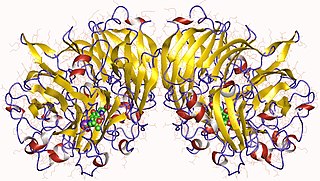
Methionine is an essential amino acid in humans.

Flavins refers generally to the class of organic compounds containing the tricyclic heterocycle isoalloxazine or its isomer alloxazine, and derivatives thereof. The biochemical source of flavin is the yellow B vitamin riboflavin. The flavin moiety is often attached with an adenosine diphosphate to form flavin adenine dinucleotide (FAD), and, in other circumstances, is found as flavin mononucleotide, a phosphorylated form of riboflavin. It is in one or the other of these forms that flavin is present as a prosthetic group in flavoproteins. Despite the similar names, flavins are chemically and biologically distinct from the flavanoids, and the flavonols.

Succinate dehydrogenase (SDH) or succinate-coenzyme Q reductase (SQR) or respiratory complex II is an enzyme complex, found in many bacterial cells and in the inner mitochondrial membrane of eukaryotes. It is the only enzyme that participates in both the citric acid cycle and the electron transport chain. Histochemical analysis showing high succinate dehydrogenase in muscle demonstrates high mitochondrial content and high oxidative potential.

In biochemistry, flavin adenine dinucleotide (FAD) is a redox-active coenzyme associated with various proteins, which is involved with several enzymatic reactions in metabolism. A flavoprotein is a protein that contains a flavin group, which may be in the form of FAD or flavin mononucleotide (FMN). Many flavoproteins are known: components of the succinate dehydrogenase complex, α-ketoglutarate dehydrogenase, and a component of the pyruvate dehydrogenase complex.

Vitamin K epoxide reductase (VKOR) is an enzyme that reduces vitamin K after it has been oxidised in the carboxylation of glutamic acid residues in blood coagulation enzymes. VKOR is a member of a large family of predicted enzymes that are present in vertebrates, Drosophila, plants, bacteria and archaea. In some plant and bacterial homologues, the VKOR domain is fused with domains of the thioredoxin family of oxidoreductases.

In enzymology, a methanol dehydrogenase (MDH) is an enzyme that catalyzes the chemical reaction:
In enzymology, a pyrroloquinoline-quinone synthase (EC 1.3.3.11) is an enzyme that catalyzes the chemical reaction
In enzymology, an alcohol dehydrogenase (acceptor) (EC 1.1.99.8) is an enzyme that catalyzes the chemical reaction
In enzymology, a choline dehydrogenase is an enzyme that catalyzes the chemical reaction
In enzymology, a quinoprotein glucose dehydrogenase is an enzyme that catalyzes the chemical reaction
In enzymology, an aldehyde dehydrogenase (pyrroloquinoline-quinone) (EC 1.2.99.3) is an enzyme that catalyzes the chemical reaction

Amine oxidase (copper-containing) (AOC) (EC 1.4.3.21 and EC 1.4.3.22; formerly EC 1.4.3.6) is a family of amine oxidase enzymes which includes both primary-amine oxidase and diamine oxidase; these enzymes catalyze the oxidation of a wide range of biogenic amines including many neurotransmitters, histamine and xenobiotic amines. They act as a disulphide-linked homodimer. They catalyse the oxidation of primary amines to aldehydes, with the subsequent release of ammonia and hydrogen peroxide, which requires one copper ion per subunit and topaquinone as cofactor:
Radical SAMenzymes is a superfamily of enzymes that use a [4Fe-4S]+ cluster to reductively cleave S-adenosyl-L-methionine (SAM) to generate a radical, usually a 5′-deoxyadenosyl radical (5'-dAdo), as a critical intermediate. These enzymes utilize this radical intermediate to perform diverse transformations, often to functionalize unactivated C-H bonds. Radical SAM enzymes are involved in cofactor biosynthesis, enzyme activation, peptide modification, post-transcriptional and post-translational modifications, metalloprotein cluster formation, tRNA modification, lipid metabolism, biosynthesis of antibiotics and natural products etc. The vast majority of known radical SAM enzymes belong to the radical SAM superfamily, and have a cysteine-rich motif that matches or resembles CxxxCxxC. Radical SAM enzymes comprise the largest superfamily of metal-containing enzymes.

Methanol dehydrogenase (cytochrome c) (EC 1.1.2.7, methanol dehydrogenase, MDH) is an enzyme with systematic name methanol:cytochrome c oxidoreductase. This enzyme catalyses the following chemical reaction
Alcohol dehydrogenase (cytochrome c) (EC 1.1.2.8, type I quinoprotein alcohol dehydrogenase, quinoprotein ethanol dehydrogenase) is an enzyme with systematic name alcohol:cytochrome c oxidoreductase. This enzyme catalyses the following chemical reaction
Alcohol dehydrogenase (quinone) (EC 1.1.5.5, type III ADH, membrane associated quinohaemoprotein alcohol dehydrogenase) is an enzyme with systematic name alcohol:quinone oxidoreductase. This enzyme catalyses the following chemical reaction
Quinate dehydrogenase (quinone) (EC 1.1.5.8, NAD(P)+-independent quinate dehydrogenase, quinate:pyrroloquinoline-quinone 5-oxidoreductase) is an enzyme with systematic name quinate:quinol 3-oxidoreductase. This enzyme catalyses the following chemical reaction
Alcohol dehydrogenase (azurin) (EC 1.1.9.1, type II quinoprotein alcohol dehydrogenase, quinohaemoprotein ethanol dehydrogenase, QHEDH, ADHIIB) is an enzyme with systematic name alcohol:azurin oxidoreductase. This enzyme catalyses the following chemical reaction
Soluble quinoprotein glucose dehydrogenase is an enzyme with systematic name D-glucose:acceptor oxidoreductase. This enzyme catalyses the following chemical reaction
Mycofactocin (MFT) is a family of small molecules derived from a peptide of the type known as RiPP (ribosomally synthesized and post-translationally modified peptides), naturally occurring in many types of Mycobacterium. It was discovered in a bioinformatics study in 2011. All mycofactocins share a precursor in the form of premycofactocin (PMFT); they differ by the cellulose tail added. Being redox active, both PMFT and MFT have an oxidized dione (mycofactocinone) form and a reduced diol (mycofactocinol) form, respectively termed PMFTH2 and MFTH2.








